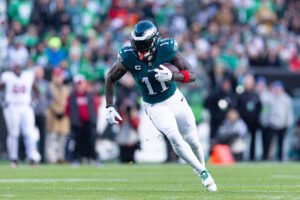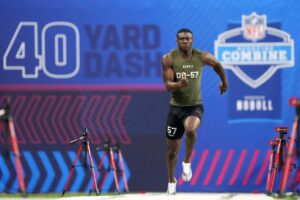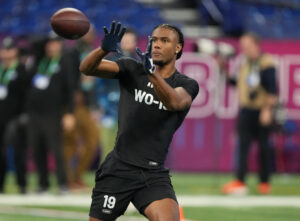The NBA trade deadline is one of the more exciting times of the regular season. Twitter riots for the few days leading up to the Thursday deadline and the Trade Machine accumulates traffic like a Los Angeles rush hour. Teams set for title runs have no problem trading future assets to plug a hole. Teams at the bottom are eager to deal players for draft picks. It’s not uncommon for big names (Demarcus Cousins this year or Pau Gasol in 2008) to be moved in exchange for picks or expiring contracts.
While both the NFL and NBA have salary caps, the major contractual differences come with the guarantees. NBA contracts are fully guaranteed. The numbers you read when Mike Conley inks a five year, $152 million contract is the money Conley will receive. On the other hand, NFL contracts rarely pay out anywhere close to the high number that scrolls across the ESPN ticker.
How do NFL Contracts Work?
There are multiple, complex parts to a typical NFL contract. First, you have the signing bonus. These are guaranteed figures, typically prorated over the length of the contract. Signing bonus’ are the most secure form of payment for an NFL player. Signing bonus money that cannot be taken from him. Secondly, there is a base salary paid to a player every season. The base salary can be guaranteed or not. Typically the final handful of years of base salary are not guaranteed whatsoever.
Additionally there are roster bonus’ (to be paid if a player is still with the team in said year) and incentives (pro bowl, playoffs, number of games played, etc.). Occasionally, contracts will include smaller injury guarantees and workout bonuses. Contracts are often back ended, resulting in a large final figure. The last few years in these deals – the more lucrative years – are typically not guaranteed. This allows the teams to simply move on from a player without a big ‘cap hit’ or ‘dead money.’ For example, cornerback A.J. Bouye‘s new deal with the Jacksonville Jaguars is listed as follows: 5 years for $67.5 million with $26 million guaranteed. This is how it breaks down:
- A $10 million signing bonus paid out $2 million a year through 2021. This is fully guaranteed regardless of whether Bouye is still with the team.
- A base salary of $3 million in 2017 and $13 million from 2018-2021. The first two years of his base salary are guaranteed.
- A roster bonus of $500,000 each of the next five seasons
There are likely other incentives and clauses in this deal that are unknown to us. Even with all this money ‘promised’ to a Bouye, Jacksonville could part with him after the 2018 season with minimal repercussions ($6 million, $4 million, and $2 million in dead cap from 2019-2021).
Details of the Brock Osweiler Trade
Last thursday, the Houston Texans traded Brock Osweiler, a second round pick in 2018, and a sixth round pick this year to the Cleveland Browns for a fourth round pick this year. Brock Osweiler’s deal that he inked last year was reported as a four year deal worth $78 million. Osweiler will not come close to seeing all of that money. What he will see is the $37 million that was ‘fully guaranteed.’ Osweiler’s contract, like Bouye’s above, guaranteed the base salary for the first two seasons ($9 million in 2016 and $16 million in 2017). Unless he is traded again, the Browns are now on the hook for the remaining sixteen million of his contract.
Will This NBA-syle Trade Set a New Trend?
The short answer that it is unlikely. Osweiler’s trade required the perfect storm of situational events. By all accounts the contract given to Osweiler by Houston in 2016 was one of the worst deals in NFL history. The sticker shock preposterous for a quarterback who made seven career starts in four seasons – 4 years for $72 million. On top of that, Osweiler picked up $21 guaranteed in the first year plus a FULLY GUARANTEED base salary of $16 million for 2017.
With the salary cap, Cleveland entered the offseason with the most available cap space in NFL history at $107.46 million. Therefore, they were capable of absorbing the sixteen-million dollars owed to Osweiler without hampering their team in the long run. Recent reports cite that Brock will likely not even be on the roster by the start of training camp. Essentially the Browns said that they were willing to pay sixteen-million dollars to obtain an additional second round draft pick.
The cap will likely continue to rise, but not to the degree we are seeing this offseason. Having an extra $107 million sticking around is as rare as it sounds. And after the dumpster fire that was Brock Osweiler’s 2016 season in Houston, teams are unlikely to give that sort of guaranteed money to an unproven commodity in the future. The concept of a salary dump and bad teams with big money absorbing contracts in exchange for assets is exciting. But it takes a rare combination of circumstances to happen. This trade may be the first of its kind, but it’s unlikely to set forth a storm of similar trades.
Are the Browns Really Playing Moneyball?
In January of 2016 the Browns hired Paul DePodesta to be their “chief strategy officer.” DePodesta was a Harvard graduate who had worked with Billy Bean and the Oakland Athletics. He was made famous by Michael Lewis‘ book Moneyball, and had been working in baseball since 1996. However, DePodesta had no football front office experience.
Contrary to popular discussion, the Browns are not really playing ‘Moneyball’. The point of Moneyball was to completely overhaul how players were being evaluated. Bean and DePodesta wanted to take an inherently flawed system and work it to their advantage. They wanted to find undervalued players that would benefit their money-strapped team. Unlike the Athletics in the early 2000s, the Browns have money to spend – and are willing to spend it. While DePodesta may assess players through a different analytical lens than others, the approach he is taking with the Browns is not the same as he did with the Athletics.
In many ways, the strategy being employed by the Browns is more similar to ‘The Process’ than to Moneyball. The Browns may not be overtly trying to lose games like the Sam Hinkie lead 76ers, but they are going out of their way to accumulate assets in a Hinkie-like fashion. The more draft capital – the higher chance of landing a franchise cornerstone. In picking up Brock Osweiler’s $16 million contract for one season (the final two years of his deal are not guaranteed and carry no dead cap if he were to be cut), the Browns picked up an additional second round pick in one of the deepest NFL drafts in recent memory.
Results of Cleveland’s Process
Hinkie’s foundation centered around accumulating lottery picks. The NBA and NFL are different in that way. In the NBA, nearly all superstar level players are found in the lottery. Second round picks rarely amount to serious assets. In the NFL stars are commonly found in the second round or later. Just examining the 2014 draft (giving three seasons to evaluate where player is at), there were some household hames and legitimate cornerstones drafted in the second round. Derek Carr, Allen Robinson, and Jarvis Landry were all second round picks in 2014
The amount of ammunition the Browns now own in draft picks resembles a Duke basketball team so rich in talent that former five-star recruits transfer because they never see the court:
2017: Two first rounders (1, 12), two second rounders (33, 52), one third rounder (65), one forth rounder (108), three fifth rounders (145, 175, 181), and two sixth rounders (185, 188)
2018: One first rounder, three second rounders, one third rounder, two forth rounders, a fifth rounder, two sixth rounders, and a seventh rounder.
However, purely obtaining draft capital is not a means to success. For their strategy to work, they will still have to draft quality players. In the 2014 draft mentioned above, Cleveland also had two first round picks (8 and 22). These picks became Justin Gilbert (traded to Pittsburgh in 2016 for a sixth round pick – later cut by the Steelers), and Johnny Manziel (no longer in the NFL). For the Browns to take advantage of their accumulation of picks, they’re going to have to draft much better than they’ve shown the ability to recently.
Conclusion
For the first time in a while, the Browns look to be making positive strides. Using the cap in creative ways have allowed them to put together a hedge-fund of draft capital. In theory, the accumulated picks could change the direction of the franchise. At this point, the Osweiler trade looks like a victory for both sides. Houston cleared money to potentially sign a quarterback to put them over the top. Cleveland used it’s cap space to acquire assets. Just don’t expect to see this type of deal regularly.
Research and contract details from overthecap.com and forbes.com
Main Photo:






